Sarah Sundin's Blog, page 416
September 2, 2013
Today in World War II History
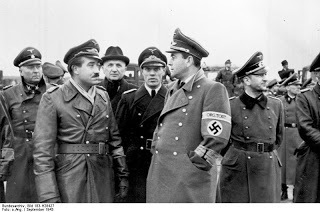 Adolf Galland and Albert Speer, September 1943 (German Federal Archive)70 Years Ago—Sept. 2, 1943: In Germany, Albert Speer is appointed to direct war production.
Adolf Galland and Albert Speer, September 1943 (German Federal Archive)70 Years Ago—Sept. 2, 1943: In Germany, Albert Speer is appointed to direct war production.
Published on September 02, 2013 01:00
September 1, 2013
Today in World War II History
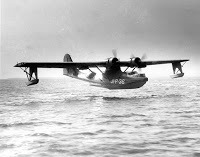 US Navy PBY Catalina used for
US Navy PBY Catalina used foranti-submarine patrols (US Navy photo)70 Years Ago—Sept. 1, 1943: US Navy assumes aerial antisubmarine warfare responsibility in the Atlantic from the US Army Air Force.
Published on September 01, 2013 01:00
August 31, 2013
Today in World War II History
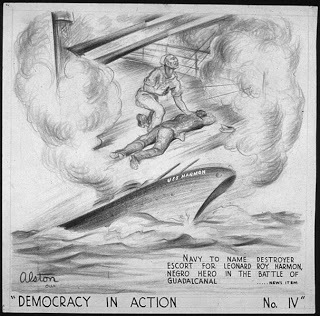 US Office of War Information poster about USS Harmon
US Office of War Information poster about USS Harmonand its namesake (US National Archives)70 Years Ago—Aug. 31, 1943: First use of Grumman F6F Hellcat in combat, in Navy raid on Marcus Island. Civil Air Patrol’s Coastal Patrol program discontinued as U-boat threat has waned. Destroyer escort USS Harmon commissioned at Quincy, MA, the first US Navy ship named for an African-American—Leonard Ray Harmon, who died in action in the Naval Battle of Guadalcanal while caring for the wounded.
Published on August 31, 2013 01:00
August 30, 2013
Today in World War II History
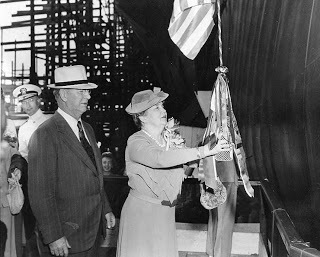 US Secretary of Navy Frank Knox and wife Annie at christening ceremony
US Secretary of Navy Frank Knox and wife Annie at christening ceremony of USS Hornet, Newport News shipyard, Virginia, 30 Aug 1943
(US Navy Naval History and Heritage Command)70 Years Ago—Aug. 30, 1943: The second USS Hornet is launched, Newport News VA. This aircraft carrier may currently be toured in Alameda CA.
Published on August 30, 2013 01:00
August 29, 2013
Today in World War II History
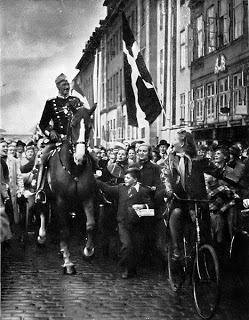 King Christian X riding through Copenhagen
King Christian X riding through Copenhagen on his 70th birthday, 26 September 1940
(during the German occupation of Denmark)70 Years Ago—Aug. 29, 1943: Germans impose martial law in Denmark; King Christian and royal family confined to his palace. Danes scuttle fleet, 13 ships escape to Sweden, only 5 captured.
Published on August 29, 2013 01:00
August 28, 2013
Today in World War II History
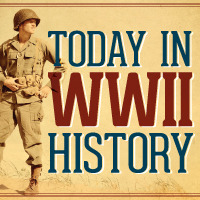 70 Years Ago—Aug. 28, 1943: Bulgaria’s Tsar Boris III (age 49) dies of unknown reasons (he resisted fascists and protected Jews), succeeded by six-year-old Simeon II. Danish government resigns; German Gen. von Hanneken takes control.
70 Years Ago—Aug. 28, 1943: Bulgaria’s Tsar Boris III (age 49) dies of unknown reasons (he resisted fascists and protected Jews), succeeded by six-year-old Simeon II. Danish government resigns; German Gen. von Hanneken takes control.
Published on August 28, 2013 01:00
August 27, 2013
Today in World War II History
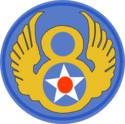 70 Years Ago—Aug. 27, 1943: US Eighth Air Force flies first mission to “Crossbow” sites—where German V-weapons are being produced. British sloop HMS Egret sunk by German Hs 293 radio-controlled bomb in the Bay of Biscay, the first ship sunk by a guided bomb.
70 Years Ago—Aug. 27, 1943: US Eighth Air Force flies first mission to “Crossbow” sites—where German V-weapons are being produced. British sloop HMS Egret sunk by German Hs 293 radio-controlled bomb in the Bay of Biscay, the first ship sunk by a guided bomb.
Published on August 27, 2013 01:00
August 26, 2013
Hospitalization in World War II - Evacuation of the Wounded
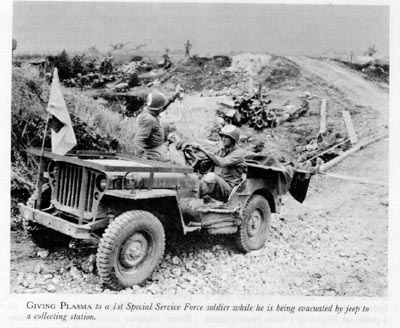 US medics administer plasma to a patient in a jeep ambulance
US medics administer plasma to a patient in a jeep ambulanceItaly 1944 (US Army Medical Dept.)Unlike the US Fifth Army, Hutch crossed the Volturno River backward. While the Allies crossed under machine-gun fire eleven days earlier, Hutch rode in a jeep, turned in the front seat to face little Lucia. Her litter was strapped across the backseat, while two more litters were strapped on the hood.
A furrow raced up Lucia's forehead, and she clutched her doll even tighter.
Time for Hutch's treat. "I have a gift for you. For Lucia." (On Distant Shores, p. 194)
In my new novel On Distant Shores , the hero serves as a pharmacist in an evacuation hospital and the heroine serves as a flight nurse. To celebrate the book’s release, I’m running a series on hospitalization in World War II. Earlier I discussed the chain of evacuation, then I discussed mobile and fixed hospitalsin more detail, and today I’ll cover evacuation of the wounded.
Manual Transport
On the battleground, medics or fellow soldiers could manually carry a wounded man further to the rear for aid. Methods included the supporting carry (walking side-by-side), the arms carry, the saddleback carry (piggy-back), and the fireman’s carry.
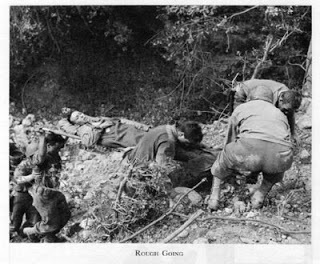 Litter-bearers in Italy's mountainsLitter Transport
Litter-bearers in Italy's mountainsLitter TransportAmerican litters were made of canvas stretched over aluminum or wood poles with stirrup-shaped feet to keep them off the ground. A litter could be carried by two people, but a litter squad consisted of four men, to rotate if traveling long distances and to assist over obstacles. Ideally, litter transport was only used for short distances, but in mountainous or forested or swampy terrain, litter transport was the only available means. Mules were often used in the Mediterranean Theater to carry litters in rocky, mountainous terrain.
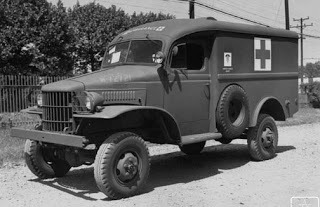 Dodge WC9 1/2 ton ambulance, 15 May 1941
Dodge WC9 1/2 ton ambulance, 15 May 1941(US National Archives)Motor Transport
Ambulances were used to transport patients, usually from an aid, clearing, or collecting station to a field hospital, or for transport further to the rear. Ambulances could carry seven seated patients or four patients on litters.
Jeeps were often used, both on the battleground and to transport further to the rear. Rugged and maneuverable, jeeps could cover terrain inaccessible to ambulances. With litter brackets, a jeep could carry two or three patients. Armored divisions also used light tanks to transport their wounded.
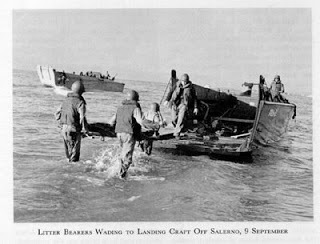 Wounded American soldiers being evacuated by landing craft (LCVP)
Wounded American soldiers being evacuated by landing craft (LCVP)off Salerno, Italy, 9 September 1943. (US Army Medical Dept.)Water Transport
During an amphibious landing, the best way to handle the wounded was to send them back on departing landing craft, which carried them to hospital ships off-shore. Patients could be removed from danger and transported quickly to get needed care.
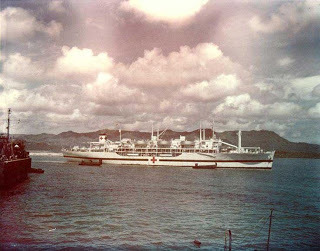 Hospital ship USS Tranquillity arriving at Guam with survivors
Hospital ship USS Tranquillity arriving at Guam with survivorsof sinking of USS Indianapolis, 8 Aug 1945. (US National Archives)Hospital ships were used offshore after an invasion to care for the wounded before field and evacuation hospitals could be set up. They also transported patients who needed long-term care to general hospitals further to the rear. Another use of hospital ships was to transport to the US any patients who needed long-term convalescent care or those who qualified for a medical discharge. They carried several hundred patients and delivered full medical care, but transport took a long time and carried the danger of enemy attack at sea, even when marked with the Red Cross.
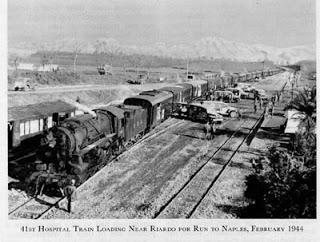 US 41st Hospital Train running from the Italian front
US 41st Hospital Train running from the Italian front to the Army hospital complex in Naples, February 1944
(US Army Medical Dept.)Rail Transport
Hospital trains were used within theaters of operation to transport patients from one hospital to another. They were used in the continental US, Britain, continental Europe, India, and North Africa. They could carry several hundred patients with excellent medical care.
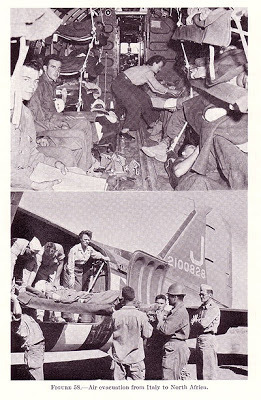 Air Evacuation from Italy to North Africa in a C-47
Air Evacuation from Italy to North Africa in a C-47(US Army Medical Dept.)Air Transport
Medical air evacuation was new and revolutionary, but by the end of the war, it proved successful. Planes can traverse inhospitable terrain or dangerous seas—and quickly. C-47 cargo planes carried 18-24 litter patients or a higher number of ambulatory patients. A team consisting of a flight nurse and a surgical technician cared for the patients in flight. The larger C-54 cargo plane was used for trans-oceanic evacuation. Danger still existed, both from the inherent risks of flight and also because the planes carried cargo, couldn’t be marked with the Red Cross, and were legitimate military targets.
For more on air evacuation in World War II, please see my posts on air evacuation, one patient's flight experience, and flight nursing.
Resources
Office of the Surgeon General. Medical Field Manual: Transportation of the Sick and Wounded. Washington, DC: US Government Printing Office, Feb. 21, 1941 (http://www.ibiblio.org/hyperwar/USA/ref/FM/index.html). Please note the date—some of the material, especially about air evacuation, became quickly outdated.
For better information on air evacuation, please see:
Links, Mae Mills & Coleman, Hubert A. Medical Support of the Army Air Forces in World War II. Washington, D.C.: Office of the Surgeon General, USAF, 1955.
Published on August 26, 2013 02:00
Today in World War II History
 70 Years Ago—Aug. 26, 1943: Germans occupy Alpine passes into Italy in anticipation of Italian surrender and German occupation. Soviets launch offensive into eastern Ukraine over River Dnieper.
70 Years Ago—Aug. 26, 1943: Germans occupy Alpine passes into Italy in anticipation of Italian surrender and German occupation. Soviets launch offensive into eastern Ukraine over River Dnieper.
Published on August 26, 2013 01:00
August 25, 2013
Today in World War II History
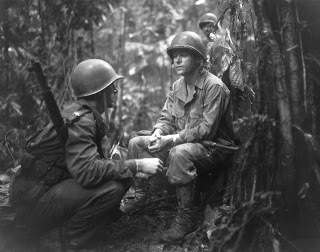 Maj. Gen. J. Lawton Collins and Maj. Charles Davis,
Maj. Gen. J. Lawton Collins and Maj. Charles Davis,New Georgia, Solomon Islands, 14 Aug 1943 (US Army photo)70 Years Ago—Aug. 25, 1943: US secures New Georgia in the Solomons after seizing Bairoko Harbor. Allies begin air raids on France and Low Countries to make Germans suspect a Pas de Calais invasion (Operation Starkey). Germans impose 72-hr work week in occupied Holland.
Published on August 25, 2013 01:00



